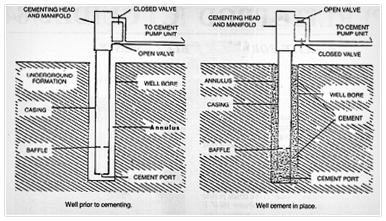Perlite for use in well cements
Well cementing
A lubricating mud consisting of water, clay, pozzolans and other materials is used to facilitate drilling of oil, gas, water and geothermal wells. This lubricating mud is forced out through the bottom of the drill casing and the space between the well bore and the casing is cemented to prevent the intrusion of corrosive waters and other contaminants into the well.
Why Perlite cement?
Well cementing materials such as diatomaceous earth, pozzolan, fly ash and glass beads do not have the lightweight properties exhibited by Perlite concrete unless concentrations of bentonite or gel, as it is referred to, are added to the cement. A disadvantage of large concentrations of gel is that they are not compatible with heat. Because Perlite cement is not affected by heat and little material is lost in cementing operations due to its ability to bridge voids, Perlite cement provides a more effective and less costly well cement. The dry weight of Perlite is only 100 kg/M 3 as opposed to 400-1600 kg/M3 – the dry weight of the other materials.
Advantages of using Perlite well cement
Lighter density
Aids in bridging
Heat compatible
Lower costs
Insulating qualities
Typical Perlite well cement aggregate screen size
A lubricating mud consisting of water, clay, pozzolans and other materials is used to facilitate drilling of oil, gas, water and geothermal wells. This lubricating mud is forced out through the bottom of the drill casing and the space between the well bore and the casing is cemented to prevent the intrusion of corrosive waters and other contaminants into the well.
Why Perlite cement?
Well cementing materials such as diatomaceous earth, pozzolan, fly ash and glass beads do not have the lightweight properties exhibited by Perlite concrete unless concentrations of bentonite or gel, as it is referred to, are added to the cement. A disadvantage of large concentrations of gel is that they are not compatible with heat. Because Perlite cement is not affected by heat and little material is lost in cementing operations due to its ability to bridge voids, Perlite cement provides a more effective and less costly well cement. The dry weight of Perlite is only 100 kg/M 3 as opposed to 400-1600 kg/M3 – the dry weight of the other materials.
Advantages of using Perlite well cement
Lighter density
Aids in bridging
Heat compatible
Lower costs
Insulating qualities
Typical Perlite well cement aggregate screen size







